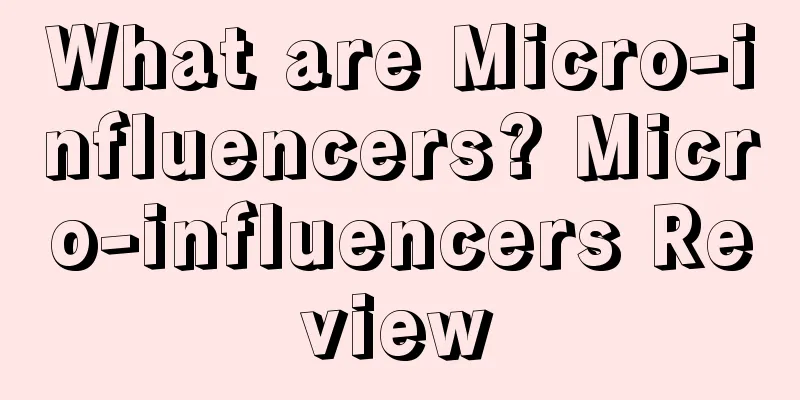What are Micro-influencers? Micro-influencers Review

Micro-influencers are a type of Internet celebrity. Unlike the traditional celebrities, experts or public figures that everyone knows, they are actually a group of passionate and energetic people who are keen on using various social media to tell and promote a certain category, a certain brand or simply an individual's story and profit from it .introduceMicro opinion leaders are ordinary consumers who have their own areas of interest or specialization, such as gardening enthusiasts, shopaholics, fitness enthusiasts, academic masters, travel experts, etc. Although they are not at the level of Internet celebrities, they have a say in this field among their relatives and friends. Micro-influencers need to cooperate with a large number of ordinary consumers, attack from multiple points, create influence from the bottom up, and also play a role in dispersing risks. InfluenceMicro-influencers have efficient brand communication, marketing placement and can even create simple and high-speed fanatical fans, which can achieve the effect of deep communication. Usually, Micro-influencers may only have thousands or tens of thousands of fans at most. value1. Micro-influencers have higher engagement rates Data shows that micro-influencers can achieve more flexible and efficient personalized marketing (the so-called "one thousand faces for one thousand people") compared to big influencers with hundreds of thousands or millions of fans. For niche brands, vertical brands, and even personalized brands, the user conversion rate, loyalty, and high customer unit price brought by personalized marketing are not something that big influencers can sustain. 2. Micro-influencers have a larger target audience 3. Micro-influencers are more affordable Compared with online celebrities, micro-influencers obviously have a more reasonable ROI in terms of cost. Usually, a cross-border e-commerce celebrity or a celebrity with millions of fans can post a single Instagram Posts promoting products or brand partnerships can cost as little as $75,000 or more. In contrast, 97% of micro-influencers only make about $500 to promote an Instagram post. 4. Micro-influencers are more authentic defect1. Each Micro-influencer can reach a small number of people, so an automated delivery method is needed 2. Micro-influencers have varying levels of content production skills. Advertisers need to provide basic materials and creative routines, and may even use a programmatic creative model. 3. Avoid being as annoying as WeChat business Advertisers just want to use payment to encourage consumers to share their experiences 4. The biggest change of micro-influencers is that they are manageable and monitorable Advertisers must clearly define their ROI targets for their advertising expenditures and monitor and optimize during the advertising process. References
|
<<: What is Selling Manager? Selling Manager Review
>>: What is Buzz Sumo? Buzz Sumo Review
Recommend
Are there risks of multiple freight forwarders going bankrupt? The companies involved solemnly declare: These are all rumors!
Customs statistics show that in 2022, the scale of...
What are Amazon direct reviews? Amazon direct reviews
The so- called Amazon direct review is to write a ...
How much is your average monthly salary as an Amazon operator? Is this line of work promising?
text Source: Zhihu Let's update Monthly salar...
What is OrangeGo? OrangeGo Review
Chengyi Overseas (Chenghui Shanghai Network Techno...
What is United Express? United Express Review
Shenzhen Union Express International Freight Forwa...
The highest price is 50,000 yuan! Bing Dwen Dwen has gone viral overseas, and is Amazon selling out?
The holiday mode of "ignoring cross-border af...
Thanksgiving spending trends in the U.S.: spending to drop to $125 billion, beauty products and other products become popular gifts
According to a survey released recently by the Int...
What is ShopeePay? ShopeePay Review
ShopeePay is Shopee’s e -money service that can no...
What is BIGO LIVE? BIGO LIVE Review
BIGO LIVE is the largest live streaming company in...
Before clearing inventory, we need to calculate the order cost of the product
Before clearing inventory, we need to calculate t...
How to grasp the rhythm of Amazon operations and what to do at each stage
Recently, I have found that many novice sellers, a...
More than 10,000 stores were closed! Amazon has taken a decisive action against this behavior
As the number of new coronavirus cases surges worl...
Five links and ways to get them for off-site promotion on Amazon
1. ASIN link (dp link) Also called dp link, it is...
Amazon launches multiple payment methods in Mexico! Helping companies grow their online business!
According to foreign media reports, Amazon has rec...









